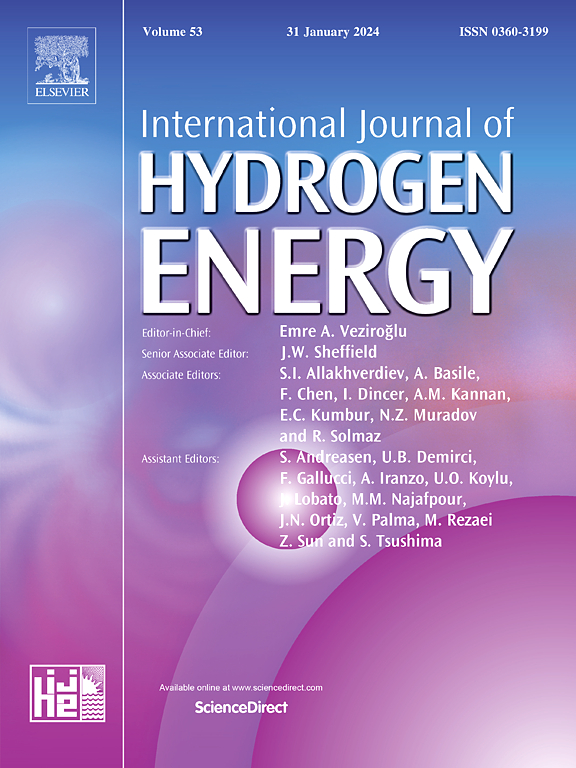紫外/过氧化氢深度氧化膜电极组件自由基降解机理研究
IF 8.1
2区 工程技术
Q1 CHEMISTRY, PHYSICAL
引用次数: 0
摘要
质子交换膜燃料电池(pemfc)商业化面临的主要挑战是成本高、耐久性差;限制其寿命的关键因素之一是自由基(•OH)对膜电极组件的攻击。本研究基于紫外线(UV)/过氧化氢(H2O2)高级氧化工艺构建定量自由基老化装置,精确调控羟基自由基的生成速率。结果表明,自由基的攻击导致聚合物的主链和侧链断裂,以及磺酸基的损失。催化剂包覆膜(CCM)的抗拉强度和吸水性能明显降低,但透气性保持稳定。催化剂层(CL)厚度减小,质量损失率增大。随着自由基的攻击,微孔层(MPL)表面的疏水性不断降低,前10 h快速脱氟和初始氧化导致疏水性降低。从10到40 h,脱氟速率减慢,但氧化继续,进一步降低了疏水性。该研究为深入了解燃料电池中自由基的老化机制,为设计耐用膜电极组件(MEA)材料提供了重要的理论依据。本文章由计算机程序翻译,如有差异,请以英文原文为准。
Study of free radical degradation mechanisms of membrane electrode assembly based on ultraviolet/hydrogen peroxide advanced oxidation process
The main challenges in the commercialization of proton exchange membrane fuel cells (PEMFCs) are their high cost and poor durability; one of the key factors limiting their lifetime is the attack of free radicals (•OH) on membrane electrode assemblies. In this study, a quantitative free-radical aging device is built based on an ultraviolet (UV)/hydrogen peroxide (H2O2) Advanced Oxidation Process, which precisely regulates the generation rate of hydroxyl radicals. The results show that free-radical attack leads to polymer backbone and side-chain breakage, as well as the loss of sulfonic acid groups. The tensile strength and water absorption properties of the catalyst-coated membrane (CCM) are significantly reduced, while the gas permeability remains stable. The catalyst layer (CL) thickness decreases, and the mass loss rate increased. The hydrophobicity of the microporous layer (MPL) surface decreases continuously with the free-radical attack, the first 10 h, rapid defluorination and initial oxidation lead to a decrease in hydrophobicity. From 10 to 40 h, the defluorination rate slows, but oxidation continues, further diminishing the hydrophobicity. This study provides an in-depth understanding of the aging mechanisms of free radicals in fuel cells and offers an important theoretical basis for designing durable membrane electrode assembly (MEA) materials.
求助全文
通过发布文献求助,成功后即可免费获取论文全文。
去求助
来源期刊

International Journal of Hydrogen Energy
工程技术-环境科学
CiteScore
13.50
自引率
25.00%
发文量
3502
审稿时长
60 days
期刊介绍:
The objective of the International Journal of Hydrogen Energy is to facilitate the exchange of new ideas, technological advancements, and research findings in the field of Hydrogen Energy among scientists and engineers worldwide. This journal showcases original research, both analytical and experimental, covering various aspects of Hydrogen Energy. These include production, storage, transmission, utilization, enabling technologies, environmental impact, economic considerations, and global perspectives on hydrogen and its carriers such as NH3, CH4, alcohols, etc.
The utilization aspect encompasses various methods such as thermochemical (combustion), photochemical, electrochemical (fuel cells), and nuclear conversion of hydrogen, hydrogen isotopes, and hydrogen carriers into thermal, mechanical, and electrical energies. The applications of these energies can be found in transportation (including aerospace), industrial, commercial, and residential sectors.
 求助内容:
求助内容: 应助结果提醒方式:
应助结果提醒方式:


